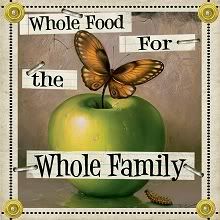Grains are full of wonderful vitamins and minerals. They are so good for us and people have lived off grains for years. The problem is that we have ruined our stomachs from all the junk in the world and the grains themselves have even been ruined in part by the GMO's and pesticides. Our bodies now have a hard time digesting these super grains and getting the goodness out of them. For many, they are now even harmful. We mustn't look at grains as the evil. We need to work towards healing our bodies so that we can use the goodness of grains and seek the grains that are uncorrupted by the GMO industries.
Grains should be a part of our diet. There will be times when people need to steer clear of them while they are healing their systems, but after that, they should be included, with prudence and correct preparation.
Soaking and sprouting, as I have talked about before, help break down the proteins and phytates in the grains which make them much easier to digest. You can use my search box to find out more on that subject. This post is about an easy way to healthify your bread with as minimal amount of work as possible. We all need that. Many get overwhelmed with the whole soaking, sprouting and drying routine. I know I did.
Last month, I bought some delicious homemade Artisan bread from a friend's daughter for a fundraiser. It was soooo yummy. We devoured it. I immediately asked her for the recipe. I was delighted to learn in was one of those no knead recipes that sits overnight and takes only minutes of prep time. I dove in and made a loaf and it was good. It was white flour and not so good for you but nonetheless, delightful. I decided that I would take this method and healthify it a bit to remove the guilt of eating it. The end product was delicious. Not as fluffy as the white version on the outside but delicious on the inside. The best part is that it is 100% whole grain, soaked bread with very little yeast! It took minutes to make! No excuses now, ladies! I didn't have that bloated feeling when eating it like I do with white bread. I just felt good.
I kept this loaf as more of a flat, rectangular shape. When cut, it resembled more of a Biscotti which was perfect for soup-dipping! It was moist and chewy and spongy. Just how an Artisan bread should be. I used 100% Kamut grain which will usually not work in a bread. It has low gluten and is usually very crumbly in bread but not made this way. I love Kamut for the protein content and low gluten but I usually keep it to muffins and pancakes. I decided to try it out and it worked perfectly. It has a very mild taste so you get that white bread taste. I served it with a light summer veggie soup, see those zucchini's again? I think we have had them every night this week. I had a bowl full of fresh picked green beans to add as well and some tomatoes that needed to be used. I even threw in some tomatillos that were on the counter. Veggie soups are a great way to use up what is in the kitchen. I add some quinoa while cooking for health benefits and to thicken the soup. It only takes 3 minutes in the pressure cooker!
To make the Artisan bread, you need some sort of dutch oven or for the best effect, a clay baker. I used the deep oval baker from Pampered Chef. It creates a good steam which gives it the chewy texture. You can use any clay, enamel, cast iron or glass bakeware that goes in the oven with a lid. You start the night before.
3 cups flour (fresh ground or sin and use white)
1/4 tsp. yeast
1 1/2 tsp sea salt
1 1/2 cups hot water
2 T. kefir or buttermilk (needed to remove phytates)
1 T. favorite seasoning (optional)
I didn't use seasoning this time but use Herbs de Provence in the other batches.
Mix the flour,yeast and salt in the bowl. Add the hot water and mix a little then add the kefir. Mix until all blended. It will be sticky and shaggy looking. Leave it in the bowl and cover with a lid or plastic wrap. Let sit up to 24 hours. There will be a bubbly appearance when ready.
When the dough is ready (for me, I usually start it at around 9 at night and by 3, I am ready to form it to a loaf although it is ready earlier), turn it onto a floured mat or counter and sprinkle it with flour. Fold it about 3 or 4 times to form a rounded loaf. Make 3 diagonal cuts on the top. Put it into your clay baker or pan with parchment lining the bottom. Cover and let rise 30 min to 2 hours. I have even forgotten mine and let it go for 4 hours and it was the best loaf I had! The less time, the more dense your bread which is sometimes preferred depending on the meal.
Preheat oven to 425. Put the pan in, covered and bake for 30 minutes. Remove the lid after 30 minutes and bake another 10-15 more or until lightly golden on top. Remove from pan and let cool.
It is so good warm but if you are eating it after it is totally cooled, I like to toast it in the broiler with some olive oil or butter. Artisan bread isn't the best cold. I love this bread with some Bruschetta, especially the batches with the herbs in the dough.
Because this is soaked for 24 hours with the kefir, you don't need to sprout your grains first. Soaking will do the work for you.
Thank you, Rachel, for giving me this recipe and for your daughter for her fundraiser! I am addicted!
If any of you need that clay baker from Pampered chef, you can check out Rachel's website here.
Some time, be a little naughty and try the recipe with the white flour. Holy moly. Just keep that to a minimum.




















8 comments:
Yum! I don't miss bread often but I do look forward to the day that I will be able to eat it again in moderation. Rachel is in my ward :) She's great!
When do you add the keifer? After the hot water??
Should have clarified this, I added the kefir after I did an initial stir so the hot water didn't hurt the kefir. I will Allen's the recipes thanks!
Thanks, auto correct...I mean amend the recipe!
what a gorgeous loaf of bread! yum! thanks for the recipe!
Could I substitue plain yogurt for the kefir/buttermilk? I just happened to see an article on buttermilk substitutions and it mentioned yogurt. But I don't know if it would have the same effect in this recipe.
Yogurt will work fine.
Have you tried this with rye flour? Do you think it would turn out as tasty?
Post a Comment